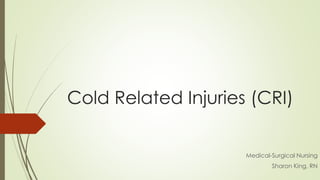
Cold related illnesses (cri)
- 1. Cold Related Injuries (CRI) Medical-Surgical Nursing Sharon King, RN
- 2. Cold Related Injuries Hypothermia Frostnip Frostbite
- 3. CRI Hypothermia: RN Focus Core temp < 95 F Environmental temp. below 82 F Wind chill: heat loss increases as wind speed rises Predisposition: Cold water immersion Acute illness (i.e flu) Trauma Shock Cold weather Age Malnutrition Hypothyroidism Inadequate clothing
- 4. Hypothermia 3 categories Mild 90-97 F Moderate 82-90 F Severe < 82 F
- 5. Hypothermia Presentation: Mild Mod. Severe Shivering muscle weakness bradycardia Dysarthia ↑ loss of coordination severe hypotension ↓muscle coordination acute confusion ↓RR “mental slowness” apathy cardiac dysrhythmias Diuresis d/t shunting incoherence ↓neurologic reflexes stupor ↓pain response ↓clotting d/t thrombocytopenia acid-base imb.
- 6. Hypothermia Intervene: Mild Sheltered from cold environment Remove wet clothing Passive (warm clothing, blanket) or active (heating blanket, warm pack, convective air heaters/warlmers rewarming Monitor skin @ least Q15-30 min Uncomplicated: warm high-carbohydrate liquid Avoid alcohol or caffeine (diuretics worsen dehydration & hypothermia)
- 7. Hypothermia Intervene: Mod—Severe Protect against furthered heat loss Handle gently 2 prevent Vfib Position supine (prevents OH) ABC Administer drugs w/caution Consider w/holding IV drugs until core temp. 86 F CPR 4 those w/o circulation
- 8. Hypothermia Intervene: Moderate Active & core rewarming: trunk b4 extremeties Monitor/prevent “After-Drop” (d/t cold blood return from peripheral 2 central circulation) Core rewarming: warmed IV fluids, heated O2, heated peritoneal, pleural, gastric or bladder lavage
- 9. Hypothermia Intervene: Severe Avoid external rewarming w/heating devices d/t rapid vasodilation Use internal rewarming: cardiopulmonary bypass, hemodialysis, venovenous or arteriovenous, or intravascular via a closed-loop indwelling catheter Cardiopulmonary bypass: fastest core rewarming Complications: Fluid, electrolyte, metabolic abnormalities ARDS ARF Pneumonia
- 10. Frostnip Superficial Produces: pain, pallor, numbness Apply warmth! Usual Areas: face, nose, finger or toes
- 11. Frostbite Risk Factor: inadequate insulation against cold Contributing Factors: fatigue, dehydration, poor nutrition, alcoholism, smoking Body tissue freezes Superficial, partial or full thickness
- 12. Frostbite Classification: 1st degree hyperemia & edema 2nd degree large fluid-filled blisters w/partial thickness skin necrosis 3rd degree small blisters w/dark fluid affected body part cool, numb, blue or red; non-blanching; full-thickness & subQ tissue necrosis; debridement 4th degree no blisters or edema, the part is numb, cold & bloodless; full-thickness necrosis 2 bone & muscle; gangrene develop
- 13. Frostbite Goal of tx: prevent further tissue damage Early signs: white waxy skin Seek shelter from wind & cold Superficial: use body heat to warm affected area
- 14. Frostbite Intervene: More Severe Forms Rapid Rewarming H20 bath @ temp. 104-108 F Hot Towel can be used Administer analgesic: IV opiates IV rehydration ! Don’t apply dry heat or massage during warming ! Handle gently Elevate above heart level if possible Assess hrly for compartment syndrome (↑ pain after analgesics & paresthesia) Compare 2 assess 4 pallor Assess pulses & muscle weakness Immunized against tetanus Apply only loose nonadherent sterile dressings Avoid compression Topical & systemic antibiotic (as indicated) Antiprostaglandin tx: ibuprofen Severe Frostbite: debridement of necrotic tissue
- 15. Thank You!!!!
